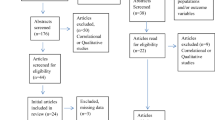Abstract
This study investigated problems commonly experienced by adolescents and the strategies they use to cope with these events. Coping strategies were examined across the subjects' omotional state and their evaluation of the problem. In general, adolescents reported four common Stressors that were similar across age groups and gender. However, males differed from females in the frequency of these problems. Further, while the Stressors were similar, the frequency with which the coping strategies were employed and the efficacy ascribed to them differed across sex and across problem type. These findings are discussed in terms of the stress and coping literature with adults and the implications for clinical assessment and treatment of adolescents.
Similar content being viewed by others
References
Billings, A. G., & Moos, R. H. (1981). The role of coping responses and social resources in attenuating the stress of life events.Journal of Behavioral Medicine, 4, 139–157.
Brown, J. M., O'Keeffe, J., Sanders, S. H., & Baker, B. (1986). Developmental changes in children's cognition to stressful and painful situations.Journal of Pediatric Psychology, 11, 343–357.
Coddington, R. D. (1972). The significance of life events as etiologic factors in the diseases of children: II. A study of a normal population.Journal of Psychosomatic Research, 16, 205–213.
Compas, B. E. (1987). Coping with stress during childhood and adolescence.Psychological Bulletin, 101, 393–403.
Curry, S. L., & Russ, S. W. (1985). Identifying coping strategies in children.Journal of Clinical Child Psychology, 14, 61–69.
Felner, R. D., Aber, M. S., Primavera, J., & Cauce, A. M. (1985). Adaptation and vulnerability in high risk adolescents: An examination of environmental mediators.American Journal of Community Psychology, 13, 365–379.
Hamburg, B. A., & Wortman, R. N. (1985). Adolescent development and psychopathology. In R. Michels & J. O. Cavenor (Eds.),Psychiatry (Vol. 2, Chap. 4). Philadelphia: J. B. Lippincott.
Hirsch, B. J. (1985). Adolescent coping and support across multiple social environments.American Journal of Community Psychology, 13, 381–392.
Kaplan, S. L., Grossman, P., Landa, B., Shenker, L R., & Weinhold, C. (1986). Depressive symptoms and life events in physically ill hospitalized adolescents.Journal of Adolescent Health Care, 7, 107–111.
Newcomb, M. D., Huba, G. J., & Bentler, P. M. (1986). Desirability of various life change events among adolescents: Effects of exposure, sex, age, and ethnicity.Journal of Research in Personality, 20, 207–227.
Petersen, A. C., & Hamburg, B. A. (1986). Adolescence: A developmental approach to problems in psychopathology.Behavior Therapy, 17, 480–499.
Spirito, A., Stark, L. J., & Williams, C. (1988). Development of a brief checklist to assess coping in pediatric populations.Journal of Pediatric Psychology, 13, 555–574.
Stattin, H., & Magnusson, D. (1981).Situation-outcome contingencies of threatening experiences: Age and sex differences. Report from the Department of Psychology, University of Stockholm, No. 580.
Stone, A. A., & Neale, J. M. (1984). New measure of daily coping: Development and preliminary results.Journal of Personality and Social Psychology, 46, 892–906.
Strober, M. (1984). Stressful life events associated with bulimia in anorexia nervosa.International Journal of Eating Disorders, 3, 3–15.
Thoits, P. (1982). Conceptual, methodological, and theoretical problems in studying social support as a buffer against life stress.Journal of Health and Social Behavior, 23, 145–158.
Walker, L. S., & Greene, J. W. (1987). Negative life events, psychosocial resources, and psychophysiological symptoms in adolescents.Journal of Clinical Child Psychology, 16, 29–36.
Wills, T. A. (1986). Stress and coping in early adolescence: Relationships to substance use in urban school samples.Health Psychology, 5, 503–529.
Author information
Authors and Affiliations
Rights and permissions
About this article
Cite this article
Stark, L.J., Spirito, A., Williams, C.A. et al. Common problems and coping strategies I: Findings with normal adolescents. J Abnorm Child Psychol 17, 203–212 (1989). https://doi.org/10.1007/BF00913794
Revised:
Issue Date:
DOI: https://doi.org/10.1007/BF00913794




